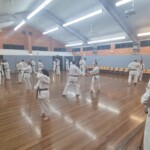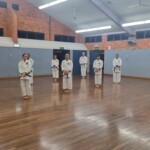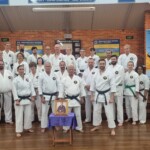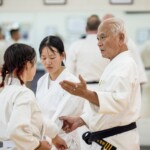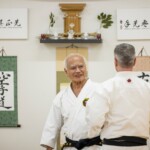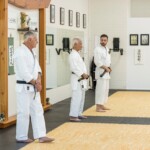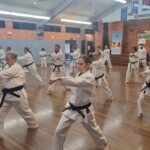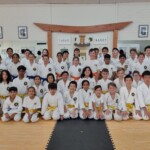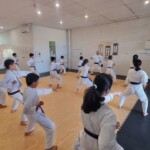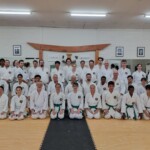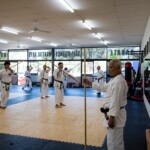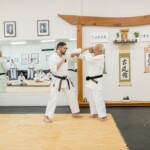Toshimitsu Arakaki sensei’s fifth visit to Australia brings practitioners from around Australia together to develop mind, technique and body [shin-gi-tai].
From 17-25 February 2023, Toshimitsu Arakaki sensei visited Australia for the fifth time to conduct training and seminars at dojo throughout the country. The visit was sponsored by the Matsubayashi-ryu Karate Association of Australia (MKAA), the Kodokan Cummings Karate Dojo, and the Australasian Federation of Traditional Karate and Kobudo (AFTK).
Canberra (ACT)
Arriving on Friday 17 February, accompanied by John Carlyle sensei, Arakaki sensei’s first leg of the tour began in Canberra, the capital city of Australia, at Reece Cummings sensei’s dojo, the Kodokan Cummings Karate Dojo.
Day one began with a pleasant cruise on Lake Burley Griffin in Canberra, where attendees were able to see and hear about important landmarks of Australia’s capital city, and had a chance to enjoy the warm weather (around 30 degrees celsius).
Afterwards, the yudansha [black belts] of the MKAA – with local students from Canberra, interstate students from New South Wales (7 hours drive), and Western Australia (30 hours drive/10 hours flight) – were instructed for two and a half hours by Arakaki sensei. In addition, students received lessons in karate (kata, kata bunkai and a strong focus on body mechanics), bojutsu, and saijutsu.
In the evening, 40 attendees, including guests from other dojo(s), joined the Welcome Dinner to celebrate the start of Arakaki sensei’s Australia tour. In addition to great food and company, everyone was treated to Arakaki-sensei playing the sanshin (an Okinawan musical instrument).
On Sunday, more than 50 practitioners gathered for a day of training with Arakaki sensei assisted by Carlyle sensei and Cummings sensei.
The day started with introducing Matsubayashi-ryu through an explanation of kihon, Fukyugata (including a demo from the Gojuryu participants) and Naihanchi. Arakaki sensei explained that to properly understand karate, you must first develop an understanding of kihon [fundamentals]. He further outlined the need for speed, use of hips, and the importance of remaining relaxed and whippy. Of course, Arakaki sensei also acknowledged that other styles might have different interpretations, but these were his as taught by Shoshin Nagamine O-sensei.
Seminar participants engaged in kotekitae [body conditioning], kata bunkai [analysis] and oyowaza [applications] of various kata sections. Sensei also taught some specific self-defence techniques, then completed the day by studying Shushi no kon and Kyan no sai.
The seminar was sponsored by the AFTK, and attended by practitioners from Matsubayashi-ryu, Shotokan, Goju-ryu/kai, Chidokan, Shudokan, Kyokushin, Shorin-ryu, and others.
On Monday, Arakaki sensei taught the regular classes at the Cummings Dojo, which more than 100 students collectively attended. Arakaki sensei spoke about the importance of maintaining traditional Matsubayashi-ryu Karatedo, as was passed down to (and through) him by Shoshin Nagamine O-sensei, and then to us.
Wingham (NSW)
On Tuesday (day five), Arakaki sensei, Carlyle sensei and Cummings sensei then headed to the mid-north coast of NSW, and the home of the Kodokan Carlyle Karate Dojo, led by MKAA Chief Instructor, John Carlyle sensei. Here, Arakaki sensei would deliver four days of training to the local students, who would also be visited by a contingent of eight Canberra dojo students and two from the Kalgoorlie dojo.
The first night of training covered karate kihon, kata, and Shushi no Kon and Arakaki sensei’s seven-set Yakusoku Kumibo, leaving students with much to take home and study.
The following nights then covered karate kata, kata bunkai and yakusoku kumite. Then, after an informal morning training, students gathered for an enjoyable lunch by the water, followed by an evening class covering bojutsu, oyowaza, kata bunkai, and for black belts, Gojushiho and Chinto kata.
A final informal free practice (day eight) on the riverside was then held with Arakaki sensei overseeing and providing small, but important, pieces of advice to help the Australian Matsubayashi-ryu students improve, and keep their techniques current and to the expected standard.
A Time for Reflection
While students gained a comprehensive insight into the physical side of the martial arts, the eight days of training provided a much deeper look into Matsubayashi-ryu as a holistic way of life. With several informal sessions on etiquette, history, tradition and lived experience – gained through Arakaki sensei’s 62 years of training – passed down both in the dojo and in between formal sessions, students are now much better educated in Okinawan karate and culture.
Arakaki sensei’s visit also provided an excellent opportunity for Matsubayashi-ryu dojo, students and instructors from around Australia to gather and remind themselves of the saying ‘ichariba chode [行逢りば兄弟]’, or, ‘though we meet by chance, we are friends for life’.
All the students of Matsubayashi-ryu Australia express their sincere gratitude and appreciation for Arakaki sensei’s kindness, passion and willingness to travel and teach, as well as to both preserve the teachings of Nagamine O-sensei and look forward innovatively to the future.
Click on an image for a full-size gallery:

